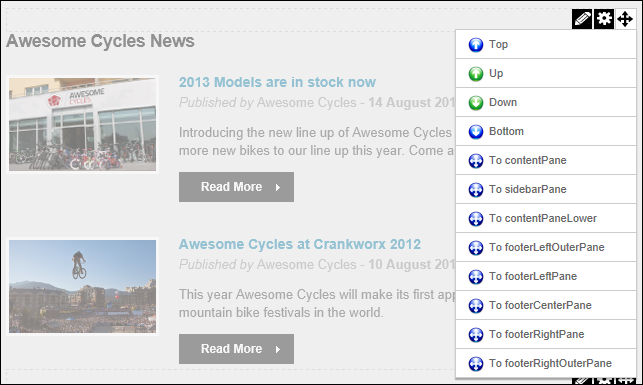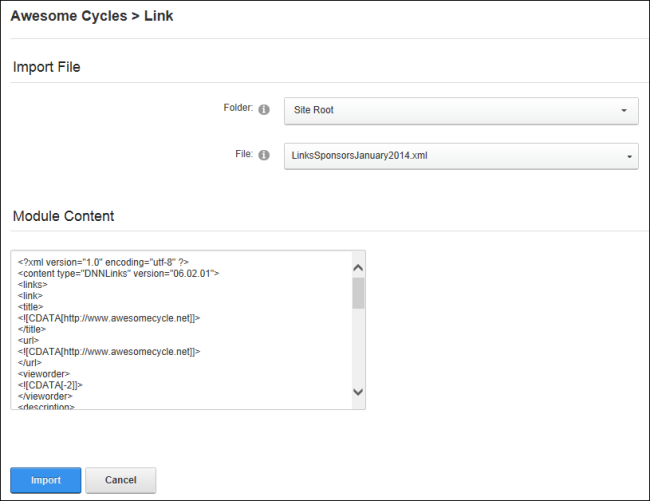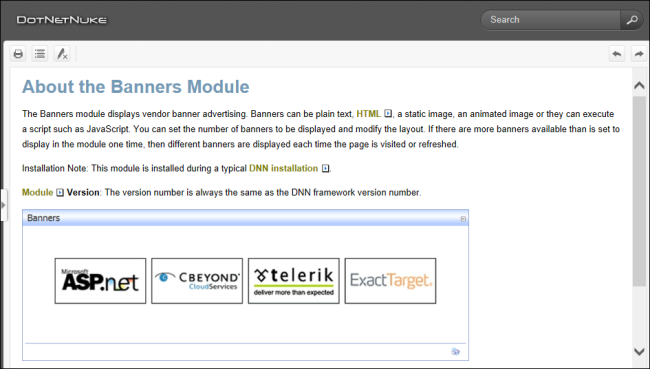About the Module Actions Menu
The module actions menu is displayed across the top of a module to users with appropriate permissions and provides quick access to module editing tools, module management tools and the module settings page.

The Actions Menu
Opening the Module Actions Menu
Some menu options are role restricted and cannot be viewed by all users. Note: The must be in edit mode to view and access the module action menu. The tools of the module action menu are divided into the three following groups:
 Edit: Mouse over the Edit
Edit: Mouse over the Edit  button to display the editing tools available to the current user. Options typically include Edit Content and My Work for the module) and Add New Item for other modules.
button to display the editing tools available to the current user. Options typically include Edit Content and My Work for the module) and Add New Item for other modules.

 Manage: Mouse over the Manage
Manage: Mouse over the Manage  button to display the module management tools that are available to this user.
button to display the module management tools that are available to this user.

 Move: Mouse over the Move button to display a list of the panes for this page where the user can move this module to.
Move: Mouse over the Move button to display a list of the panes for this page where the user can move this module to.

Edit Tools
 Edit Content: Add new content or edit the existing content to the module. See "Adding Module Content"
Edit Content: Add new content or edit the existing content to the module. See "Adding Module Content"
 My Work: Allows users to view their current workflow tasks for the / Pro module.
My Work: Allows users to view their current workflow tasks for the / Pro module.
Manage Tools
 Settings: Opens the module settings page for this module. This page provides Editors and Administrators with access to configure a wide range of module settings. Important. Ensure the Mode option is set to Edit on the .
Settings: Opens the module settings page for this module. This page provides Editors and Administrators with access to configure a wide range of module settings. Important. Ensure the Mode option is set to Edit on the .
 Export Content: Exports module content as an XML file so it can then be imported it into another module of the same type. E.g. users can only import content from a Links module into another Links module. Modules that allow content import/export are known as modules. Examples include the Announcements, FAQ, Help, Links, Media, Repository, Survey, / Pro and XML. Note: This option may be disabled in the menu. To export content, select
Export Content: Exports module content as an XML file so it can then be imported it into another module of the same type. E.g. users can only import content from a Links module into another Links module. Modules that allow content import/export are known as modules. Examples include the Announcements, FAQ, Help, Links, Media, Repository, Survey, / Pro and XML. Note: This option may be disabled in the menu. To export content, select  Manage >
Manage >  Export Content from the module actions menu and choose the folder to export the content to. Enter a name for the file into the File text box and then click the Export button. Note that the module type is displayed in the File text box by default. It can be useful to keep the module name as the start of the file name to easily identify the module type in the future. E.g. Links_Sponsors_January2014
Export Content from the module actions menu and choose the folder to export the content to. Enter a name for the file into the File text box and then click the Export button. Note that the module type is displayed in the File text box by default. It can be useful to keep the module name as the start of the file name to easily identify the module type in the future. E.g. Links_Sponsors_January2014

Exporting Content
 Import Content: Enables exported content to be imported into modules. Note: Content must first be exported from a module of the same type. E.g. users can only import content from a Links module into another Links module. Note: This option may be disabled in the menu.
Import Content: Enables exported content to be imported into modules. Note: Content must first be exported from a module of the same type. E.g. users can only import content from a Links module into another Links module. Note: This option may be disabled in the menu.
- Select
 Manage >
Manage >  Import Content from the module actions menu. This opens the Import page.
Import Content from the module actions menu. This opens the Import page.
- Expand the Import File section.
- At Folder, select the folder where exported file is located from the drop down list.
- At File, select the file name from the drop down list.
- Optional. Expand the Content section and edit or remove any unwanted content.
- Click the Import button.
Tip: If the module already contains content, the imported content is merged with the existing content.

Importing Content
 Syndicate: Enables users to view a syndicated feed of the module content. This feed can be downloaded to a user's local computer or displayed in another module such as the News Feeds (RSS) module.
Syndication must be enabled on the Setting page of a module. See "Configuring Basic Page Settings for Modules"
Syndicate: Enables users to view a syndicated feed of the module content. This feed can be downloaded to a user's local computer or displayed in another module such as the News Feeds (RSS) module.
Syndication must be enabled on the Setting page of a module. See "Configuring Basic Page Settings for Modules"
 Help: Select to view module information and user help.
Help: Select to view module information and user help.

 Print: Provides a print friendly copy of the module content for printing. Print must be enabled on the Setting page. See "Configuring Basic Page Settings for Modules"
Print: Provides a print friendly copy of the module content for printing. Print must be enabled on the Setting page. See "Configuring Basic Page Settings for Modules"
 Develop: Allows ASP.net and DNN developers to edit and add files. See "Developing Modules"
Develop: Allows ASP.net and DNN developers to edit and add files. See "Developing Modules"
 Delete: Delete the module. See "Restoring Deleted Modules"
Delete: Delete the module. See "Restoring Deleted Modules"
 Refresh: Refreshes the module with the latest content.
Refresh: Refreshes the module with the latest content.
Move Tools
 Top: Move the module to the top (above all other modules) within the current pane.
Top: Move the module to the top (above all other modules) within the current pane.
 Up: Move the module up one position within the current pane.
Up: Move the module up one position within the current pane.
 Down: Move the module down one position within the current pane.
Down: Move the module down one position within the current pane.
 Bottom: Move the module to the bottom (below all other modules) within the current pane.
Bottom: Move the module to the bottom (below all other modules) within the current pane.
 To [PaneName]: Move the module to another pane on the current page. Alternatively, See "Configuring Advanced Page Settings for a Module"
To [PaneName]: Move the module to another pane on the current page. Alternatively, See "Configuring Advanced Page Settings for a Module"
Open topic with navigation






